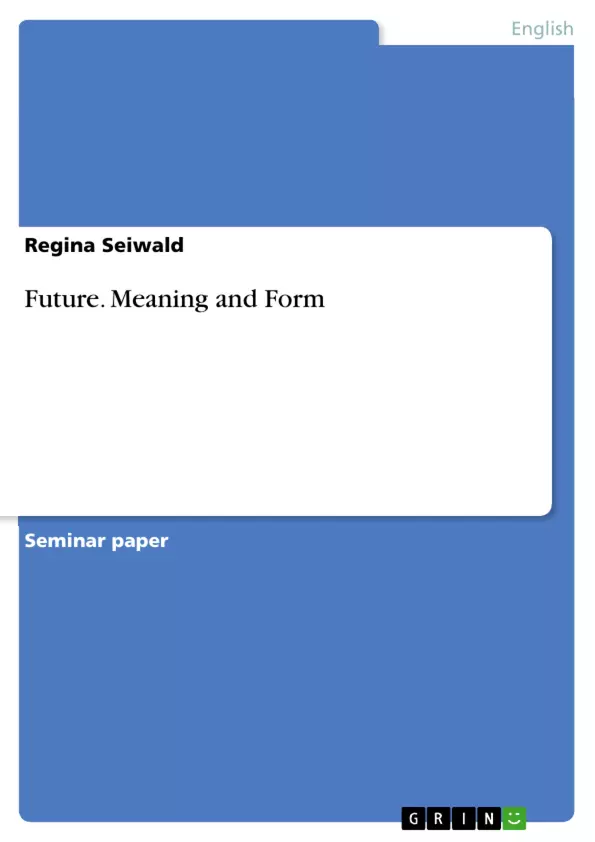This Proseminar paper is about “Future – Meaning and Form”, following the presentation held in the Awareness III. course in winter term 2007/08. In order to analyse the different forms and meanings of the various future concepts, there are several English Grammar books providing useful theoretical information.
The first part of the paper serves as a theoretical overview. In this section the different future concepts are analysed and the meaning of the different tenses is dissected. The second part consists of the practical part. It illustrates where and why the different future concepts are used in different examples. It also shows how the rules in the theoretical part apply to the practical examples like dialogues and full texts.
In English, like in all Germanic languages, there is no simple future tense. The futurity of an action is expressed either by using a word which expresses a future action, e.g. I drive to London in two days, or by utilising an auxiliary construction that combines a definite present tense verb with the stem of this verb which illustrates the actual action of the sentence.
The English future tense was established during the period of 300 years, between 1066 and 1350. During that time, Anglo-Norman was the official language of the British Isles. Unlike English, Norman is a Romance Language, which does have a simple future tense.
In the course of the study of the English future concepts, one has to make a difference between spoken and written language. As spoken language is used more often than written language, the used future tense differs.
Table of Contents
- Introduction
- I. Theoretical Part
- A. Preface
- B. Will/Shall Future
- C. Going to Future
- D. Present Continuous
- E. Comparison of Structure
- F. Present Simple with Future Reference
- G. Future Perfect
- H. Future Continuous
- I. Adverbial Time Clauses
- J. Idiomatic Expressions
- K. Future in the Past
- L. Auxiliaries
- M. Verb Patterns which express Future
- II. Practical Part
- A. Will and be going to
- B. Present Simple and Present Continuous for the Future
- C. Future Continuous and Future Perfect (Continuous)
- D. Weather Forecast
- E. Newspaper Article
- III. Conclusion
- IV. Bibliography
Objectives and Key Themes
This Proseminar paper aims to analyze the various future concepts in the English language, examining their form and meaning. It delves into the theoretical foundations of these concepts, exploring their historical development and contrasting them with present-day usage. This paper also aims to provide practical examples of how these future concepts are utilized in spoken and written English.
- The historical development of the English future tense
- The distinction between spoken and written English in terms of future tense usage
- The different forms of future expressions in English, including "will/shall," "going to," "present continuous," and "present simple"
- The contextual factors that influence the choice of future tense
- The application of these concepts in practical examples, such as dialogues and texts.
Chapter Summaries
The theoretical part of the paper begins with a preface that introduces the concept of future tense in English and its historical development. It then explores the "will/shall future," discussing its usage in predictions, spontaneous decisions, formal announcements, and expressions of personal opinion.
The "going to future" is then examined, focusing on its use for plans, intentions, and predictions based on evidence. The chapter on the "present continuous" discusses its function in expressing future arrangements, fixed plans, and ongoing actions.
The practical part of the paper explores the use of "will" and "be going to" in various contexts, as well as the application of the "present simple" and "present continuous" to express future events. It also delves into the use of "future continuous" and "future perfect" in practical situations, concluding with examples of weather forecasts and newspaper articles.
Keywords
The key themes and concepts explored in this paper include English grammar, future tense, "will/shall future," "going to future," "present continuous," "present simple," spoken and written English, future predictions, plans and intentions, and practical examples.
- Quote paper
- Regina Seiwald (Author), 2008, Future. Meaning and Form, Munich, GRIN Verlag, https://www.grin.com/document/89562



